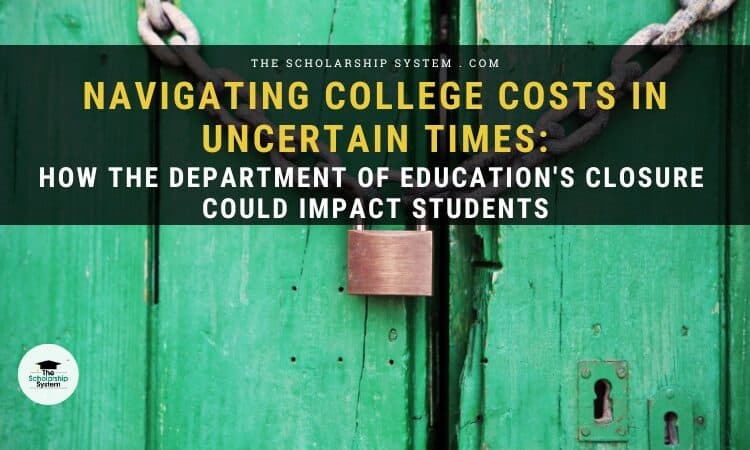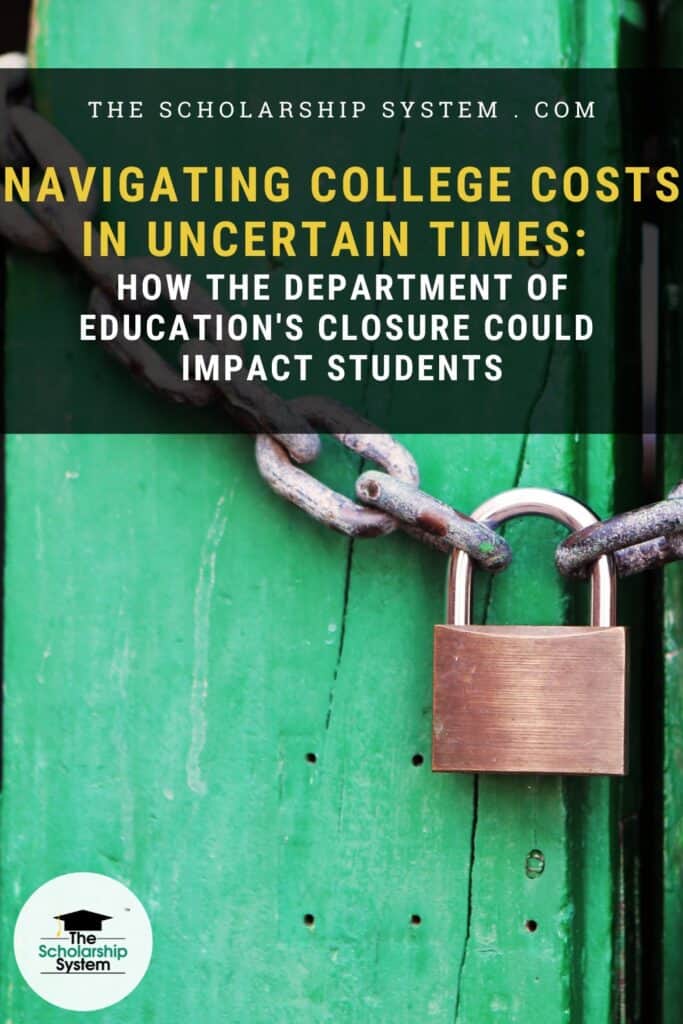Updated on March 30th, 2025
Understanding the Education Department’s Responsibilities
The U.S. Department of Education plays a crucial role in supporting students, schools, and institutions through funding, oversight, and policy enforcement. The DOE is responsible for disbursing Title I funds to elementary and secondary schools that serve low-income students, ensuring that these schools have the necessary resources to provide quality education. Additionally, the department collects data on schools, recognizes accrediting agencies, and enforces anti-discrimination laws to protect students from racial and sex-based discrimination. These efforts help maintain educational standards and ensure that any student, regardless of their background, have access to learning opportunities.
If your student wants to boost student success by making college more affordable, we can help! Sign up for our free college scholarship webinar to learn more about the scholarship process! Head over to http://thescholarshipsystem.com/freewebinar to reserve a spot today.
One of the most critical functions of the Education Department is managing federal student financial aid programs, including grants, loans, and work-study opportunities. The potential shutdown of the education department could have significant implications for federal student loan policies, affecting loan forgiveness programs and repayment plans, especially amidst ongoing legal challenges faced by borrowers. The Department of Education administers federal student financial aid programs, including Pell Grants, which provide essential support to low-income students pursuing higher education. In fiscal year 2024 alone, the department awarded approximately $120.8 billion in federal loans, grants, and work-study funds, making higher education more accessible to millions of students across the country. Without this financial support, many students would struggle to afford tuition, books, and other necessary expenses associated with obtaining a degree.
Potential Effects of Eliminating the Education Department
Recent discussions about dissolving the Department of Education have raised concerns about the future of student financial aid, civil rights protections, and institutional funding. The Trump administration has signed an executive order to dismantle the U.S. Department of Education, further intensifying debates about the potential consequences of such a move. However, completely eliminating the department would require congressional approval, adding a significant legislative hurdle to the process. The elimination of this federal agency would drastically reshape the education system in the United States, and many fear the consequences would disproportionately affect low-income students and marginalized communities.
Effects on Federal Student Loans, Student Loan Forgiveness, and Funding
If the Education Department were abolished, the structure of federal student aid could collapse, leading to confusion, higher costs, and fewer protections for students. Another agency could administer federal student loans if the Education Department is eliminated, but this transition could create significant challenges in maintaining the current level of support and oversight. Many students would find college unaffordable without federal loans, restricting higher education to those with significant financial resources. This shift could create an even wider gap between students from wealthier backgrounds and those from low-income families.
Public universities, which rely heavily on federal funding, could face significant budget shortages if states fail to compensate for the loss of federal support. Many states might not have the financial capacity to replace the funding currently provided by the DOE, exacerbating the financial strain on public institutions. This could lead to higher tuition costs, forcing students to take on more private loans with higher interest rates or forgo higher education altogether. Additionally, the student debt crisis, already a significant concern, would likely worsen as millions of borrowers struggle with uncertainty over repayment plans and student loan forgiveness programs currently under federal oversight.
Civil Rights and Special Needs Protections
Federal education laws, such as the Individuals with Disabilities Education Act (IDEA), provide essential protections and resources for students with disabilities. While these laws would still exist if the Education Department were eliminated, there would no longer be federal oversight to ensure compliance. Instead, IDEA funding would likely be distributed to states as block grants, giving state governments full control over how the money is allocated. While some states might continue to prioritize special education, others might redirect the funds elsewhere, leaving students with disabilities at a disadvantage.
Without federal accountability, there would be no guarantee that schools provide appropriate services to students with special needs. Currently, federal funding for special education is allocated based on student population needs, ensuring that resources are distributed equitably. Eliminating the Education Department could disrupt this system and create disparities in how students with disabilities receive support across different states.
Impact on Colleges and Universities
Higher education institutions, particularly those dependent on federal funding, could face significant challenges if the Education Department were dismantled. Federal grants, such as those provided by the Rural Education Achievement Program (REAP), are essential for supporting basic services and educational needs in rural school districts, which often have limited resources. Historically Black Colleges and Universities (HBCUs), for example, rely on federal funding and could experience financial instability, leading to potential enrollment declines and a loss of educational opportunities for students of color.
The removal of direct institutional funding would also create a more competitive environment among colleges and universities. While some policymakers argue that this would encourage efficiency and innovation, many education experts fear that it would force institutions to cut programs, increase tuition, or reduce financial aid options instead. The lack of federal oversight could also lead to the rise of predatory for-profit colleges that take advantage of students through misleading practices and subpar education. Additionally, dismantling the Department of Education could weaken federal protections against predatory lending practices for borrowers, leaving them more vulnerable to exploitation.
If institutions struggle to secure funding, overall college enrollment could decline, affecting students and the broader economy. About 42.7 million Americans owe $1.77 trillion in student loan debt, highlighting the critical role of accessible higher education in supporting economic mobility. A less-educated workforce could lead to decreased economic mobility and fewer skilled workers in critical industries.
Navigating Changing Education Policies
Students, parents, and educators must prepare for potential shifts in education policy, primarily if the Education Department is eliminated or its role is significantly reduced. Student financial aid administrators are particularly concerned about how such changes could impact federal student aid distribution, as they play a critical role in ensuring that funds are effectively managed and disbursed to students. Staying informed about policy changes that could affect federal student aid and education funding is crucial. Parents and students should advocate for education policies that prioritize accessibility and affordability by making their voices heard through petitions, community meetings, and direct engagement with elected officials.
It is also vital to monitor congressional action to ensure that lawmakers uphold student protections and continue allocating necessary funding for schools. The role of government in education should not be underestimated, as federal oversight helps maintain accountability and accessibility. Engaging with policymakers and voicing concerns about proposed changes can help prevent drastic cuts to essential programs and services.
Executive Orders and Tax Implications on Scholarships
Beyond funding concerns, changes to federal tax policies could significantly impact college affordability. The Trump administration’s actions and intentions regarding the Department of Education, including executive orders and legislative proposals to dismantle the agency and return authority over education to individual states, have also influenced these discussions. Republican lawmakers have proposed modifying or eliminating key federal tax credits, such as the American Opportunity Tax Credit (AOTC) and the Lifetime Learning Credit (LLC). These tax credits currently provide financial relief for tuition costs, helping millions of students and families manage the economic burden of higher education.
Why the Education Department Matters
The U.S. Department of Education plays an essential role in ensuring equal educational opportunities and maintaining affordability in higher education, supported by the federal government through funding and oversight. The Treasury Department has been discussed as a potential manager of federal student loans, raising concerns about the implications for student loan borrowers and financial aid distribution. By administering federal student loans, the department helps students afford college and access repayment plans and loan forgiveness programs. Without this support, many students would be forced into private lending systems that often come with high interest rates and fewer borrower protections.
The department is also responsible for protecting civil rights in elementary, secondary, and postsecondary education. It ensures that students are not discriminated against based on race, gender, or disability, creating a safer and more inclusive learning environment. Additionally, the department regulates for-profit colleges, preventing predatory institutions from exploiting students with misleading practices and subpar education.
Many of these protections could weaken without federal oversight, leading to a less accessible and equitable education system. The conversation surrounding the future of the Education Department is ongoing, but its importance in shaping opportunities for students nationwide cannot be overstated. Ensuring that all students have access to quality education and equal opportunities should remain a priority, regardless of political debates and policy changes.
How to Advocate for Your Education: Steps to Take as a Current College Student
Students can take action by contacting their congressional representatives, participating in student-led advocacy groups, and staying informed about education policy changes. Signing petitions, attending town hall meetings, and using social media to raise awareness can also influence policymakers to protect student funding.
Beyond direct political action, students can also work with their universities to push for increased institutional aid and tuition assistance programs. Joining student government or advocacy groups like the United States Student Association (USSA) or the National Association for Student Financial Aid Administrators (NASFAA) can provide a platform to voice concerns and propose solutions. Ensuring universities prioritize affordability and accessibility will be critical in an era of reduced federal oversight.
Resources for Students
Here are some helpful resources to stay informed and find alternative funding options:
Federal Student Aid Website (studentaid.gov) – For updates on FAFSA, Pell Grants, and federal loans.
The Scholarship System (thescholarshipsystem.com) – Strategies for finding and applying for scholarships.
State Education Departments – Many states offer their own grant and loan programs.
Consumer Financial Protection Bureau (cfpb.gov) – Information on student loans and borrower protections.
If your student wants to boost student success by making college more affordable, we can help! Sign up for our free college scholarship webinar to learn more about the scholarship process! Head over to http://thescholarshipsystem.com/freewebinar to reserve a spot today.









Leave a Reply